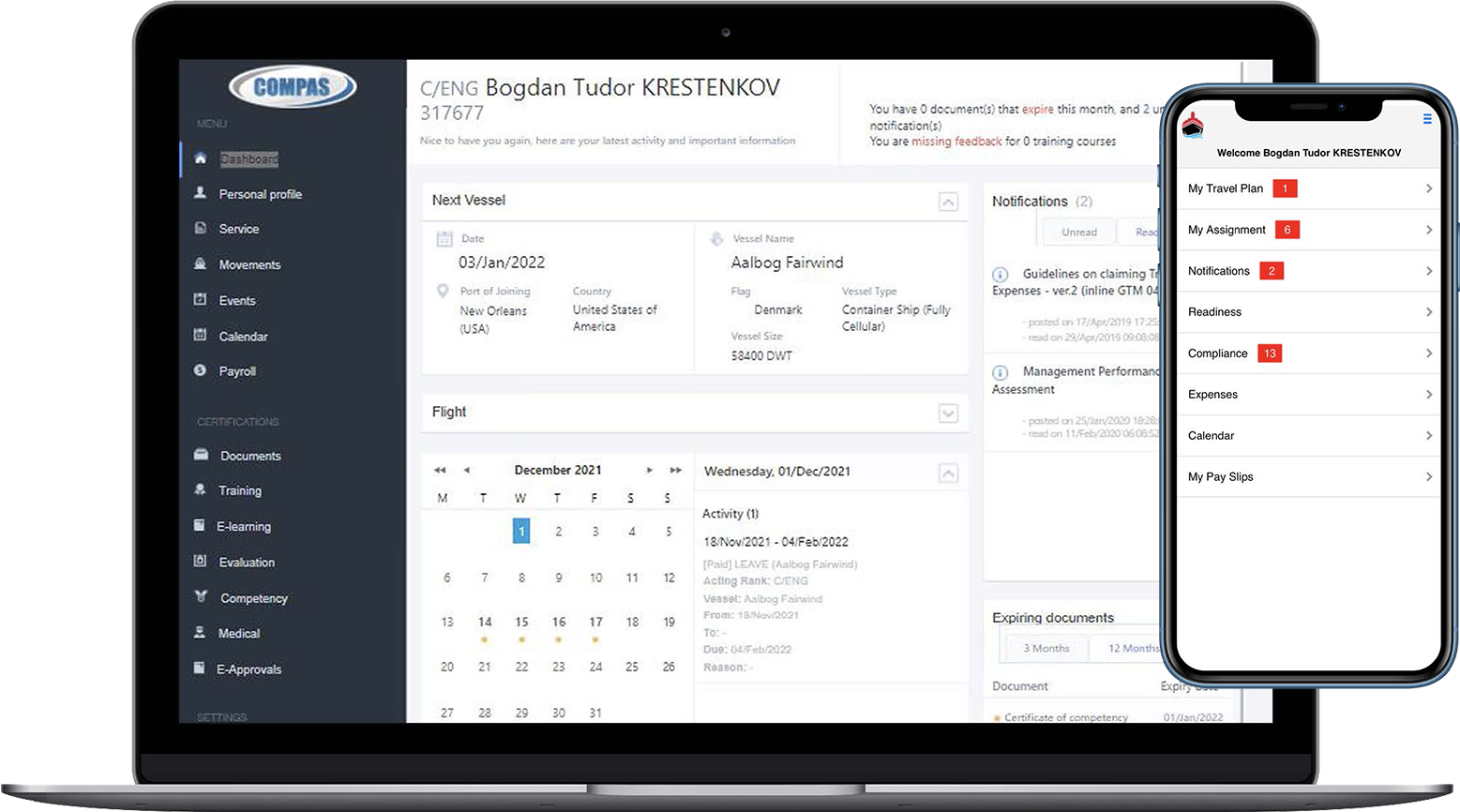The maritime industry plays a key role in the global economy and covers a wide range of activities — from building ships and running ports to fishing, cruising, and transporting over 80 percent of the world’s goods by sea. All of this depends on skilled professionals, with around 1.9 million people working at sea.
Whether it’s a cargo ship with 30 crew members or a cruise ship with 2,000, people are at the heart of every vessel. That’s why managing crews effectively is essential – and technology can help with that. Let’s explore what crew management involves and how it can be digitized.
What is ship crew management?
In the maritime industry, crew management is a range of activities related to overseeing and organizing personnel onboard vessels. It encompasses
- recruitment,
- deployment,
- training,
- scheduling,
- payroll management,
- travel arrangements,
- insurance and health schemes, and so on.
Crew management aims at finding qualified personnel, as well as ensuring safe and efficient operation, crew well-being, and compliance with regulations and company policies.
Who handles crew management?
Typically, there’s no single person responsible for all of the crew management activities (except for smaller vessels like boats or yachts). Depending on the type of vessel and voyage organization, different scenarios are possible. Even within ship chartering, there are various models.
For example, both a voyage charter and time charter agreement usually imply hiring a ship together with the crew (so it’s a shipowner's responsibility to find, train, and deploy personnel, while a charterer takes care of their well-being and safety), but in the bareboat charter, all the crew-related issues are handled by the charterer.
In addition to that, in many cases, HR activities are outsourced to a specialized crew management company.
What is a crew management company?
A crew management company (also called crewing/manning agency) is a third-party organization that provides manning services for fleet owners, vessel managers, or charterers for a commission. Typically, such companies have an international network or pool of seafarers and multiple offices around the world to meet the manning demand of different vessels. Many of them also offer education and training services, as well as certification programs for mariners.
Depending on the agreement scope, crewing agencies can perform all or some of the HR-related activities we listed above, attracting, training, and retaining ship personnel.
Some of the biggest global crewing agencies are V.Group, Anglo-Eastern, Bernhard Schulte Shipmanagement, and OSM Thome.
Due to its importance and with so many parties engaged in crew management, streamlining these operations becomes a strategic priority. And it’s only possible through the transition from legacy methods (think pen and paper, fax machines, and manually-filled spreadsheets) to new, integrated technologies that allow executives to automate workflows. Let’s see how it works.
Ship crew management software (CMS)
Crew management software (CMS) is the digital platform that helps optimize all HR-related processes of companies that operate in the maritime industry. Such systems are designed to minimize the administrative workload, reduce paperwork, support crew-related decisions, and ensure compliance with ISM, MLC, STCW, and other maritime regulations.
CMS can be used by both shipping businesses that actually operate fleets and crew management companies. Let’s look at the core functionality of CMS.
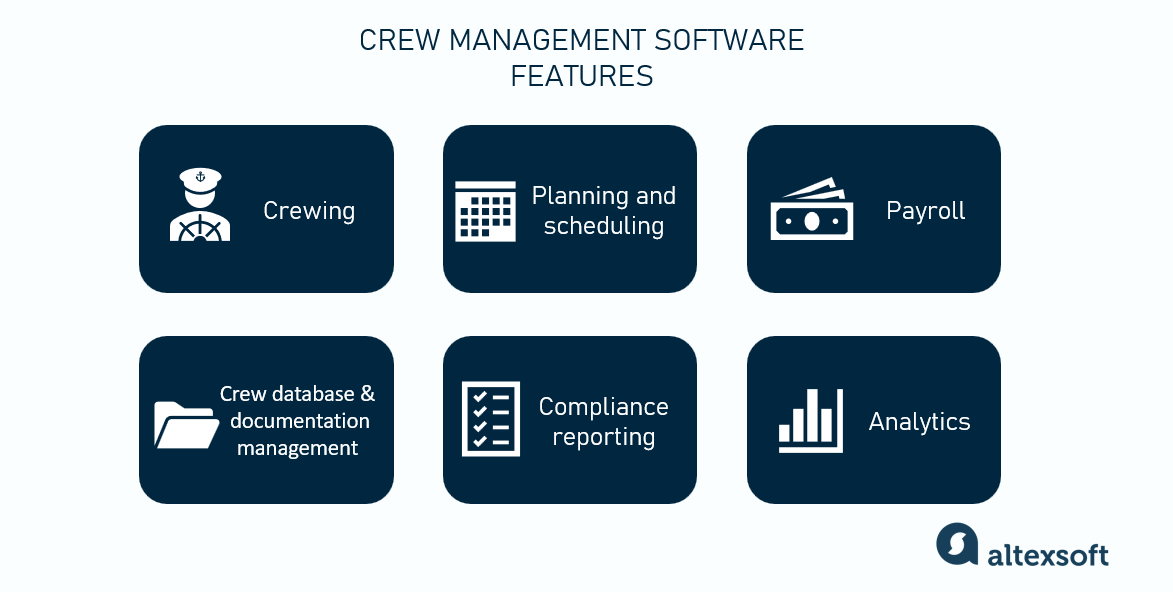
Main crew management software features
Crewing (recruitment)
Selecting the best candidates is a challenge in any industry. The recruitment module of the CMS helps create talent pools and select seafarers who best fit the requirements of a specific vessel. Most CMS products also consider the oil industry specifics and allow you to work with crewing matrices (complex, labor-intensive documentation related to oil majors' requirements from Oil Companies International Marine Forum).
Applicant management capabilities help add new crew members faster by auto-processing incoming CVs. Follow-ups can also be automated to reduce the HR workload.
In addition, bulk registering functionality optimizes crew deployment as personnel go through a safety briefing and other pre-departure procedures.
Planning and scheduling
It’s equally important to strategically plan the manning needs and also to create fair, efficient schedules. Since this involves many factors (e.g., business objectives, available resources, people skills, financial restrictions, and other hard and soft constraints), doing it manually is just too complicated.
Crew management software helps plan the optimal personnel composition and amount depending on the vessel type, journey duration, logistics requirements, etc.
It can also create a crew rotation schedule considering crew skills and competencies, work/rest hours requirements (stipulated by regulations like STCW and the MLC), and various personal preferences. Vacations and sick leaves can also be added.
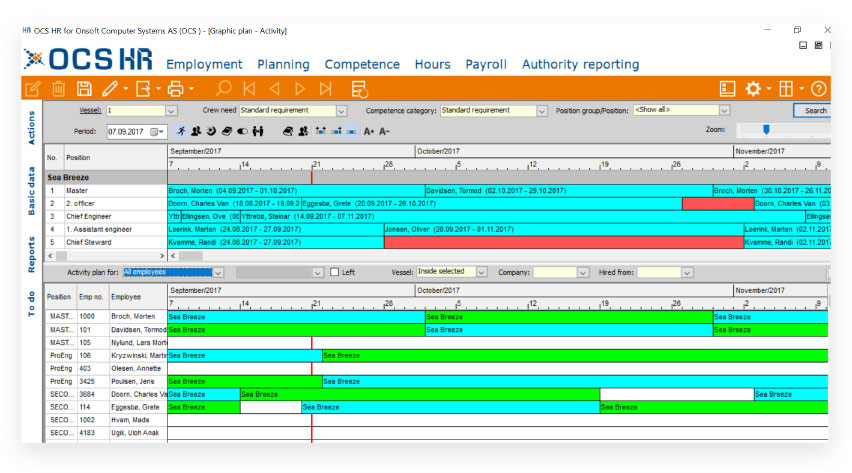
MINTRA OCS HR crew rotation module
CMS allows planners to conveniently view schedules by location, crew, vessel, or other criteria.
Importantly, modern CMS is able to handle the international date line crossing and automatically adjust time according to the geographic location.
Payroll processing
In any business, a key to staff retention is salaries paid out accurately and on time. In the maritime world, though, it gets more complicated since the crew is usually multinational, so payroll management involves dealing with multiple currencies, wage scales, tax regimes, accounts, and pension deduction schemes. In addition, there are different payroll reporting requirements in every county.
All these complexities make the payroll module tailored to the maritime industry an essential component of any CMS. It helps automate wage-related operations, reduce human error, and ensure compliance. In addition to salary calculation, it also helps handle other crew-related expenses like overtime, leave pay, cash to master, allotment, etc.
Crew database and documentation management
CMS serves as a complete database of all crew-related information. It includes such data as
- personal employee details (name, address, contact details, next of kin, emergency contact name and number, etc.);
- contract information;
- information about past employment, career development, and appraisals;
- payroll data;
- medical history;
- rota schedules;
- education and training certificates;
- related business expenses data; etc.
These records are crucial for allocating tasks, reviewing performance, checking eligibility, tracking licenses, filling out various documentation (reports, safety management system compliance, etc.), and so on.
And it’s not only about keeping or retrieving data when necessary. For example, CMS helps generate contracts for different positions. It can also be configured to automatically send alerts when, say, the expiry date of the seaman certificate is approaching.
Note that a CMS database must be compliant with data security regulations like GDPR.
Compliance reporting
To enhance safety and aid operations, the maritime industry is subject to compliance from many regulators – from IMO to national and port authorities. Multiple reports must be submitted, but filling them out takes too much time.
CMS and other tech solutions help with data collection and reporting procedures. As we said, since all crew-related data (performance, expenses, work/rest hours, etc.) is stored in a single system, it becomes easier to fill out reports and submit them online.
Analytics
In addition to industry regulations, internal reporting is crucial for enhancing business intelligence. More and more companies today collect and analyze data to find areas for improvement and support decision-making, and technology plays a key role in this process.
Some crew-related KPIs that a CMS helps monitor are
- Crew retention/turnover rate,
- Crew cost metrics,
- Crew utilization rate,
- Training metrics,
- Illness and injury statistics,
- Recruitment funnel metrics (e.g., average time to fill a vacancy), etc.
Other useful modules that are often part of the CMS can include insurance management, corporate travel arrangements, skill assessment, learning solutions, and so on.
Often, a crew self-service portal is also created to give seafarers access to their data from a dedicated app.
Crew management software providers
Here are some providers that offer robust crew management solutions that you can check out.
We chose these CMSs based on their strong reputations, comprehensive feature sets, and suitability for different operational needs in the maritime industry. The described systems are for overview purposes only; we are not promoting any of the vendors.
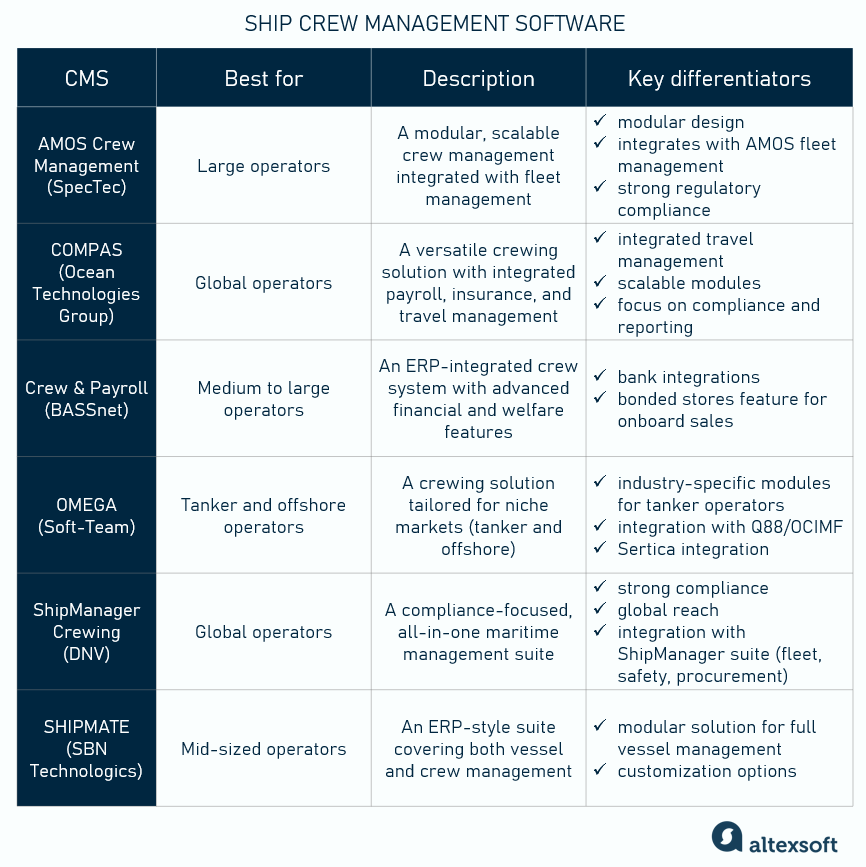
Crew management solutions comparison
AMOS Crew Management – SpecTec
Best for: Operators seeking a modular, scalable crew management solution with strong integration capabilities, particularly for those already using SpecTec's broader fleet management system.
Core modules and features:
- Crew Scheduling
- Payroll Management
- Training and certification tracking
- Compliance monitoring (MLC, STCW, etc.)
- Crew rotation & deployment management
- Integrated with SpecTec’s AMOS Fleet Management
Key differentiators:
AMOS Crew Management is part of the AMOS suite from SpecTec, which is known for its integrated approach to fleet and asset management. The modular design allows operators to scale up and add functionalities as their needs grow. This solution excels in environments where fleet management and crew management must be tightly integrated, providing seamless data flow across operational areas. Additionally, AMOS supports both onshore and offshore operations, with a strong focus on regulatory compliance and crew certification tracking.
COMPAS – Ocean Technologies Group
Best for: Ship managers looking for a versatile crewing solution with integrated payroll, insurance, and travel management.
Core modules and features:
- Crewing
- Payroll
- Insurance management
- Reporting dashboards
- Seafarer self-service portal
- Integrated travel management system with API links to external agents.
Key differentiators:
COMPAS combines robust crewing and payroll features with built-in travel booking integration, reducing manual coordination with external agents. Its dashboards provide strong visibility into compliance and HR metrics, while the self-service portal empowers crew members to manage their own data.
As part of Ocean Technologies Group, COMPAS benefits from access to wider maritime learning and performance tools, making it appealing for companies seeking a broad HR and compliance ecosystem.
Crew & Payroll – BASSnet
Best for: Large operators seeking an ERP-integrated crew system with advanced financial and welfare features.
Core modules and features:
- Crew and Payroll management
- Planning and scheduling
- Training and travel booking
- Bank integrations for salary transfers
- Bonded stores sales with payroll deductions
- Crew self-service mobile app
Key differentiators:
BASSnet differentiates itself with its bonded stores feature, which allows onboard sales to crew with automated payroll deductions, reducing cash handling and boosting welfare. Its strong integration with banking systems simplifies payroll across multiple jurisdictions. Combined with the mobile self-service app, BASSnet provides both management and crew with practical, real-world tools that support efficiency and engagement.
OMEGA – Soft-Team
Best for: Tanker operators and ship managers who require deep, specialized compliance features.
Core modules and features:
- Crewing
- Payroll
- Applicant management
- Seafarer self-service portal
- Tanker vessel module
- Add-on modules (flight requests, gangway control, dashboard analyzers, video guides, etc.).
Key differentiators:
OMEGA stands out with its dedicated tanker module, which is tightly integrated with essential tanker vetting platforms like Q88 and OCIMF. This simplifies the management of complex crewing matrices demanded by oil majors, reducing administrative workload and the risk of costly vetting rejections.
Furthermore, its full integration with the Sertica fleet management platform makes it a strong choice for companies seeking a best-of-breed solution for both crewing and technical management.
ShipManager Crewing – DNV
Best for: Large shipowners and managers seeking a compliance-focused, all-in-one maritime management suite tightly integrated with technical and safety operations.
Core modules and features:
- Crewing
- Payroll
- Planning and scheduling
- Deployment management
- Data collection and reporting
- Integration with broader ShipManager suite (fleet, safety, procurement, technical modules).
Key differentiators:
ShipManager Crewing’s primary advantage is its origin from DNV, the world's largest classification society. This CMS stands out for its strong emphasis on regulatory compliance, supporting MLC 2006, STCW, and other flag state requirements.
Its integration within DNV’s wider ShipManager ecosystem ensures seamless data flow across crewing, safety, and technical management, reducing silos and improving operational visibility.
SHIPMATE – SBN Technologics
Best for: Mid-sized ship operators needing an ERP-style suite covering both vessel and crew management.
Core modules and features:
- Crew management and payroll
- Crew competence management
- Work & Rest Hours compliance
- Scheduling and travel arrangements
- Appraisal management
- Insurance and reporting
- Seafarer’s self-service portal
- Integrations with banks, training systems, and travel agents
Key differentiators:
SHIPMATE offers a comprehensive suite that extends beyond crewing to cover full vessel management, making it attractive for operators wanting fewer separate systems. The Work & Rest Hours module supports MLC and STCW compliance, while external integrations improve efficiency across payroll and travel processes. Its balanced functionality and customization options make it a good fit for companies that want breadth rather than niche specialization.
Crew management system integrations
Crew management software can come in various forms. It can be a standalone solution or a part of the comprehensive fleet management system. You can also opt for implementing only a certain module, e.g., just a payroll or a scheduling tool.
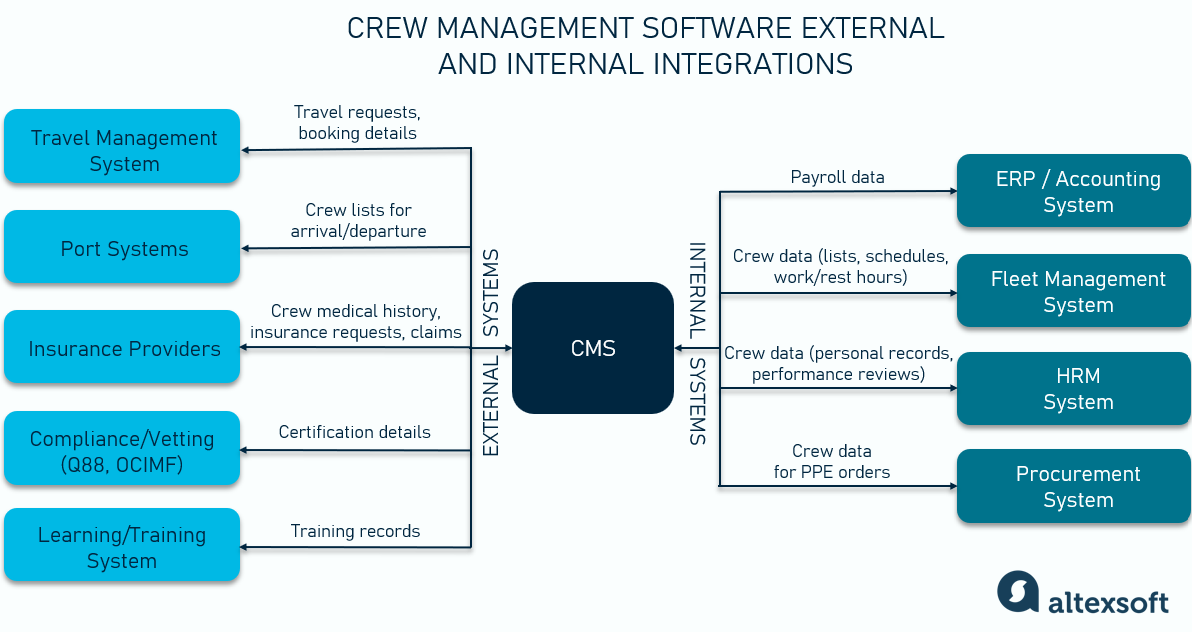
CMS integrations
In any case, though, it’s essential to build connections between all the parts of your IT ecosystem to enable seamless data exchange. For example, the CMS must be integrated with an accounting tool to share payroll information and other financial data. And integrating the CMS with the procurement system can ensure that personal protective equipment (PPE) orders are aligned with planned crew changes.
If you only use separate focused modules, connect them to the database of your main business application to store and exchange all the necessary information.
If you operate a crewing agency, consider building a connection with your website so that candidates’ applications go directly to your database.
External integrations also help to conveniently exchange data. If you work with travel agents to arrange crew transfers and repatriation, it’s worth integrating with their system so that you can easily share booking requests with all the necessary details, track their status via your system’s interface, manage invoices, etc.
How to choose ship crew management software
Selecting the CMS is a critical decision for shipping companies, as it directly impacts operational efficiency, regulatory compliance, and crew satisfaction. To make the best choice, companies must evaluate their unique needs, resources, and long-term goals.
Factors to consider
Of course, functionality is what matters most. Note that most CMS platforms use modular architecture, which helps maritime companies go digital step by step. Instead of spending a lot on a full system at once, you can start with the most urgent needs. For example, if you struggle with Port State Control checks, you can first add a Work & Rest Hours module. If admin work is burdensome, begin with automated payroll.
Pricing model. Vendors offer different pricing models for their CMS platforms, each with strategic implications:
- Per-vessel/per-month – common for comprehensive platforms, where pricing is based on the number of vessels, with tiered plans offering different feature sets. This model is ideal for companies where the fleet size directly impacts costs.
- Per-user/per-month – often used by SaaS providers, this model charges based on the number of users accessing the system, making it suitable for companies with a stable workforce.
- Active user/user banding – this model adapts to the fluctuating maritime workforce, where costs are tied to the number of actively deployed crew or predefined user bands, ensuring more predictable billing.
- Subscription vs. upfront license – the industry is shifting towards cloud-based subscription models, reducing the need for high initial investments in licenses and hardware, making it more accessible for smaller companies.
Each model has its advantages, and the choice depends on factors like fleet size, workforce dynamics, and budget flexibility. So do your calculations and choose the one that works best for you.
Total cost of ownership. The subscription or license fee is only one component of the total investment. A comprehensive TCO analysis must account for all associated costs over the software's lifecycle, such as
- implementation,
- data migration,
- customization,
- integration,
- training, etc.
Scalability. Ensure the system can handle your current fleet size and expected growth.
Compliance. Check support for IMO FAL forms, STCW, MLC, PSC inspections, and flag-specific reporting.
Integration. Ask whether the CMS integrates smoothly with your existing Planned Maintenance System (PMS), ERP, travel, and banking systems.
Crew experience. A user-friendly portal or app improves crew satisfaction and reduces admin overhead.
Analytics. Look for systems with strong KPI tracking (work/rest compliance, turnover, training, etc.).
Deployment model. Cloud solutions offer lower upfront costs, but some owners prefer on-premises for security reasons.
Vendor support and localization. Verify global support coverage if you need it – or look for solutions that focus on the regions you operate in.
Data security and ownership. Check data security protocols, where data is hosted, and the policy regarding data ownership and extraction.
Implementation and support. Ask the vendor what their standard implementation process looks like, what resources are required from your side, and what level of training and ongoing support they provide.
How to approach CMS selection for different companies
There is no single "best" CMS; the optimal solution depends on your specific profile and priorities. Here’s a general framework that might be helpful.
Small to medium-sized operators. If you’re running a smaller fleet (less than 50 vessels), prioritize simplicity, ease of use, and cost-efficiency. Look for an off-the-shelf solution that can be scaled up as your operations grow. You may not need all the bells and whistles of a larger system, so a modular solution with key features like payroll, crewing, and compliance should suffice.
Options to consider: SHIPMATE, CrewInspector
Large, global operators with mixed fleets. Larger companies often need a customizable CMS that can handle complex scheduling, large crew sizes, and cross-border compliance. Consider integrating multiple systems (e.g., fleet management, payroll, travel) to create a cohesive platform. Cloud-based solutions are often best for large-scale operations, offering flexibility, scalability, and multilocation access.
Options to consider: ShipManager (DNV), AMOS
Niche operators (e.g., tanker, offshore). For operators with specialized needs, such as tanker management, look for a CMS with built-in industry-specific features or modules that integrate with platforms like Q88 or OCIMF. Niche solutions can streamline processes like tanker vetting or hazardous material management while maintaining compliance.
Options to consider: OMEGA, Onboard Tracker
Buy or build?
Most shipping companies should consider purchasing an off-the-shelf CMS if their needs align with existing products. A ready-made system can save you time, money, and development effort. Consider buying if
- Your fleet is of a manageable size and complexity.
- Your business processes are fairly standard (e.g., crew scheduling, payroll).
- You need quick deployment and don’t have extensive IT resources.
Building a custom product from scratch is a large project that requires significant investment. However, the benefit is obvious – you get your own software tailored to your specific business needs. Consider building a custom system if
- You have complex, non-standard workflows that aren’t fully supported by commercial solutions.
- Your company requires tight integration with proprietary systems or tools.
- You’re looking for full control over the system’s development, customization, and future upgrades.
- You have the IT resources (or can afford a development team) to maintain and support the system.
Before deciding, assess your existing IT infrastructure, define the workflows that most require automation, and evaluate your resources.
For example, if you run a crewing agency and these HR activities are your primary business focus, it might be worth developing a proprietary platform that will perfectly cover all your workflows, thus increasing efficiency. But if you operate, say, a mid-size shipping company and just want to enhance your fleet management with a couple of specialized crew or payroll-related modules, it makes more sense to get a focused, off-the-shelf product.
AI in maritime crew management
As in other industries, artificial intelligence is a potential game-changer in maritime crew management, helping ship operators move beyond manual planning and reactive processes. By leveraging large data sets — from crew profiles and certificates to voyage history and performance evaluations — AI-powered modules can support faster decision-making and reduce administrative workload.
Here are some possible AI applications in crew management.
Predictive scheduling and manning needs. AI analyzes past voyages, seasonal demand, and regulatory requirements to forecast crewing needs in advance, helping managers reduce last-minute crew shortages or overstaffing.
Smart recruitment and applicant screening. Natural language processing can automatically review incoming CVs, compare them to job requirements, and rank candidates, freeing HR staff from repetitive manual checks.
Compliance monitoring. AI tools track work/rest hour patterns and flag potential violations before they occur, minimizing the risk of Port State Control detentions and fines.
Crew performance analytics. By combining training history, voyage feedback, and appraisal data, AI can highlight high-performing seafarers, identify skill gaps, and recommend tailored training programs.
Attrition and welfare insights. Predictive models can spot early warning signs of turnover risk or crew dissatisfaction, allowing managers to intervene with support measures before issues escalate.
Some tech providers are already incorporating AI in their CMSs. Here are a few examples.
MariApps offers IntelliCrew, an AI-powered system designed to streamline crew changes. It automates off-signer selection and recommends optimal on-signers based on criteria like certifications, availability, voyage schedules, and cost.
A relatively new player, VoyageX AI offers a ship management platform that uses AI to automate crew operation tasks, HSSEQ compliance, and regulatory tracking.
Cloud Fleet Manager uses AI to extract the seafarer’s details from the relevant documents and auto-fill the profile.
The maritime industry is known as a relatively slow adopter of innovative tech solutions. Many companies operate on legacy systems and are reluctant to invest in modernization. However, if you want to sail toward greater efficiency, now is the time to embrace digitization in all aspects of fleet management both at sea and on the shore – crew management included.

Maria is a curious researcher, passionate about discovering how technologies change the world. She started her career in logistics but has dedicated the last five years to exploring travel tech, large travel businesses, and product management best practices.
Want to write an article for our blog? Read our requirements and guidelines to become a contributor.


